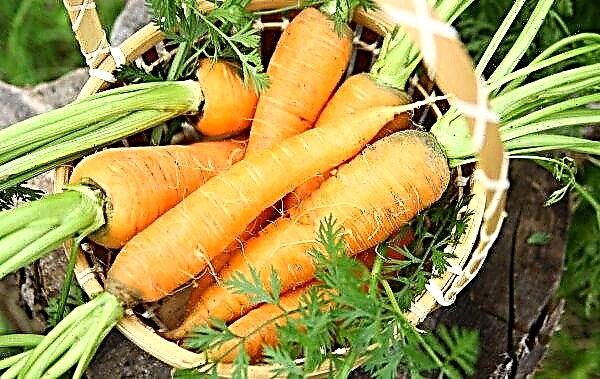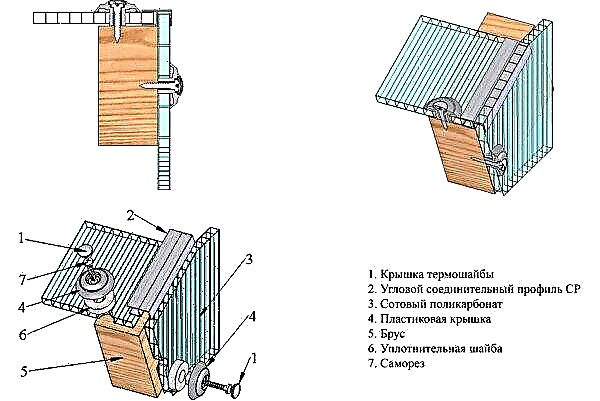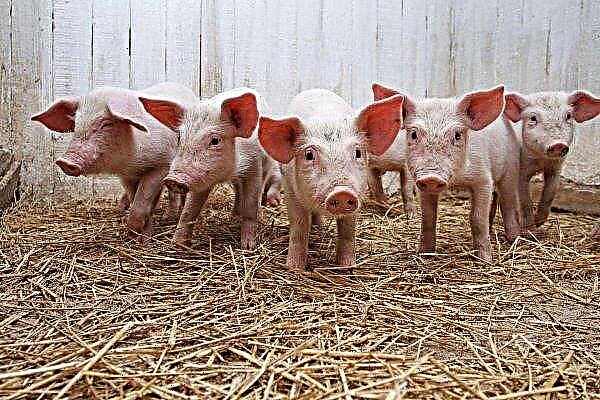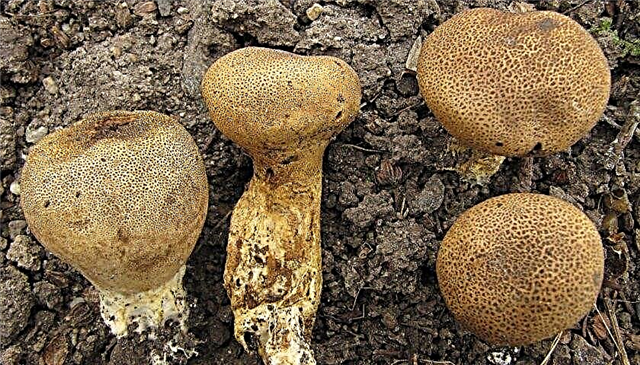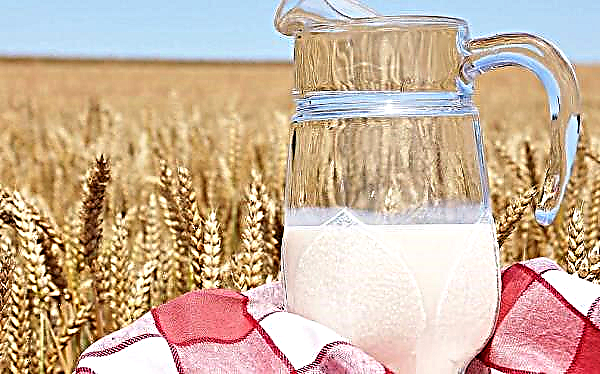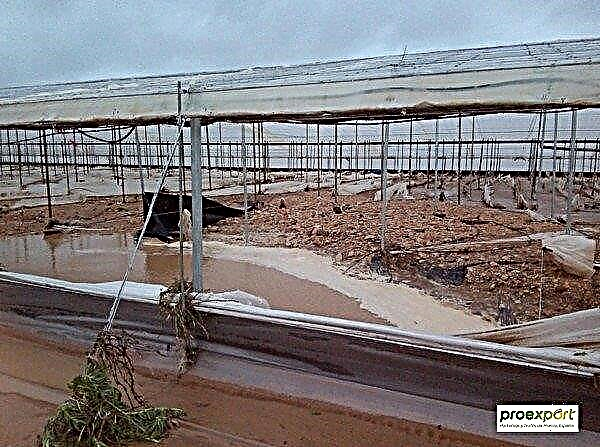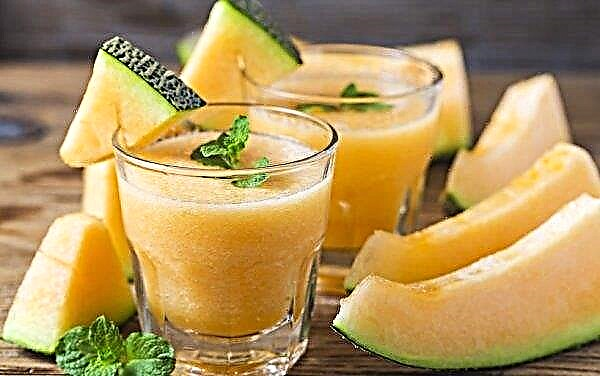Watermelon is the favorite culture of many gardeners, so it is not surprising that many are trying to grow fragrant fruits on their own site. But, when cultivating a plant, most face serious problems associated with the thermophilicity of most varieties of culture. This article will examine in detail how the watermelon of Sugar Baby variety differs from other hybrids, and also describes the main secrets of its cultivation.
Description and characteristics of watermelon Sugar baby
Watermelon Sugar baby (baby) is an ultra-early fruit variety that is versatile. The vegetative period of the variety is often in the range of 70–90 days. The culture is ideal for fresh consumption as well as processing.
The plant is intended for cultivation in open soil, but can be successfully cultivated in a greenhouse.
The fruits of the variety are regular spherical in shape, medium in size. The surface of the fruit is smooth, even, the skin color is saturated dark green. Thin strips of black appear on top of the main color. They stretch from the base to the top of the watermelon. The peel is thin, but strong, resistant to mechanical damage. On the cut, the inner part is juicy, loose and granular, rich scarlet. The pulp is rich in numerous seeds of black-brown color. The taste of the crop is high, the fruits are juicy, fragrant and sweet.
The peel is thin, but strong, resistant to mechanical damage. On the cut, the inner part is juicy, loose and granular, rich scarlet. The pulp is rich in numerous seeds of black-brown color. The taste of the crop is high, the fruits are juicy, fragrant and sweet.
Hybrid productivity is high, the average fruit weighs from 3.5 to 6 kg, while up to 10 kg of watermelons can be collected from 1 m². Subject to all the rules of planting and care, the plant is able to produce 10-15 fruits from 10 m² of plantings.
The plant is resistant to most characteristic diseases, and is also resistant to cold and sudden changes in temperature. That is why the variety can be successfully grown in any climatic conditions, from the south to the north.
Did you know? Watermelon is one of the oldest fruit plants cultivated as early as 5 thousand years ago. It is customary to consider South Africa to be its homeland, where even today one can meet its wild variety - the plant is a colonite.
Advantages and disadvantages of the variety
- The advantages of this variety are quite a lot, first of all, they include the following:
- good yield and excellent taste of fruits;
- increased storage and transportability of watermelons;
- versatility, watermelon is suitable for fresh consumption, as well as a variety of processing, including preservation;
- increased immunity against specific infections;
- resistance to cold.
The variety has practically no drawbacks, however, many vegetable growers emphasize that the plant is not suitable for cultivation in a humid climate. Often this provokes an extension of the maturation of watermelon, which sometimes affects the quality and taste of the pulp. In addition, this plant cannot boast of large fruits, which may disappoint lovers of large and fleshy watermelons.
In addition, this plant cannot boast of large fruits, which may disappoint lovers of large and fleshy watermelons.
Features of sowing seeds
Compliance with all the subtleties of sowing is considered one of the main conditions that ensure plants not only intensive growth, but also increased productivity. For this, it is necessary to observe both the specific sowing pattern and various preparatory measures to be taken in advance.
These include seed treatment and activation, as well as soil preparation. At the same time, it is enough to strictly comply with all standard measures that are put forward by the fundamentals of agricultural technology for the cultivation of melons.
Soil preparation for sowing
Watermelon grows well and bears fruit only on loose and well-fertilized soilTherefore, before sowing, the site must be carefully prepared. They begin the procedure in the fall, after leaf fall. At this time, the soil on the site is thoroughly cleaned of the remains of vegetation and other debris, and then the planting site is well plowed to a depth of about 25-30 cm. If the fertile soil layer is less thick, the plowing depth may be reduced. In the event that the soil on the site is depleted, the soil must be fertilized before autumn plowing. To do this, make manure, humus or compost on top, with a calculation of 5 kg / m².
If the fertile soil layer is less thick, the plowing depth may be reduced. In the event that the soil on the site is depleted, the soil must be fertilized before autumn plowing. To do this, make manure, humus or compost on top, with a calculation of 5 kg / m².
After wintering, the soil is again plowed, while the depth of cultivation can be reduced to 20 cm. Immediately 3-4 days before sowing watermelon, harrowing of winter fallow in 2 tracks is carried out. After this, the substrate under the culture becomes soft, moisture- and breathable, which allows to obtain maximum yield.
Important! The best substrate for watermelon is loamy and sandy loamy soil. If the plot has denser soils, the soil mixture must be lightened with river sand, with a calculation of 1–5 buckets per m².
Preparing watermelon seeds for sowing
Watermelon seeds require all kinds of preparatory measures before sowing. The first thing to do is to disinfect the seed from spores of fungi and dangerous bacteria.
For this, the seeds are soaked in special sterilizing agents:
- in 70% alcohol solution, for 5-10 minutes;
- in 2% potassium permanganate, about 20-30 minutes;
- in 15% hydrogen peroxide, not more than 10 minutes.
 During sterilization, seeds can be rejected. Those that float on the surface of the liquid are recommended to be removed and disposed of. In most cases, they do not sprout, so their further use is impractical.
During sterilization, seeds can be rejected. Those that float on the surface of the liquid are recommended to be removed and disposed of. In most cases, they do not sprout, so their further use is impractical.About 12 hours before planting, the seeds are placed in a solution of special growth stimulants. These substances contribute to the instant rooting of seeds, and also at times increase their germination.
The most popular and effective among them are the drug "Potassium Humate", "Vympel", "Kornevin" and "Zircon". After soaking, the seed becomes completely ready for application to the substrate.
Direct sowing
Pre-prepared seeds are sown no earlier than the second half of April, while the deadline for the procedure is mid-May. During this period, stable warm weather should form, with an average daily minimum of at least +14 ... + 16 ° C.
The seeds are often sown in a row-like manner, in shallow holes (with a diameter of about 20 cm). At the same time, the distance between neighboring plants should be at least 1 m, and row spacing about 1-2 m. About 3-5 seeds are placed in each small hole. On light soils, the depth of their occurrence should be about 10 cm, and on heavy soils, within 4-6 cm. The seeds are not tightly wrapped in soil, otherwise their germination capacity will decrease significantly. Further, the crops should be carefully watered and left alone until germination.
The seeds are not tightly wrapped in soil, otherwise their germination capacity will decrease significantly. Further, the crops should be carefully watered and left alone until germination.
After the appearance of sprouts, the beds are thinned out, they are made so that no more than 1 full-fledged plant develops from one growth point. With successful thinning, the sowing procedure is considered completed.
The subtleties of watermelon care
Like any fruit crop, for successful growth and high yield, watermelon needs compulsory care throughout the entire vegetative period. The procedure consists in timely watering, tillage, as well as fertilizing the site and pest control.
Watering
Sugar baby is able to withstand prolonged drought, however, in order to get the largest and most juicy fruits, the plant must be watered well. Until 3-4 real leaves appear, the beds are moistened daily, in the future, the procedure is carried out 1 time per week.
Water the soil so that the moisture completely wet the upper, 60-centimeter layer of soil. For this, about 7 liters of water are used per adult plant, for young shoots this indicator should not exceed 3 liters. Water is applied to the beds under the root, or using surface irrigation. To do this, use only clean, settled water, with a temperature of at least +20 ... + 22 ° C.
Water is applied to the beds under the root, or using surface irrigation. To do this, use only clean, settled water, with a temperature of at least +20 ... + 22 ° C.
Did you know? Watermelon is one of not many fruit plants that occupy an intermediate position between fruits and vegetables. Its closest relative is considered to be pumpkin, zucchini and other melons, while the fruit has a sweet taste and belongs to the type of berries.
Top dressing
Watermelon often suffers from a nutrient deficiency in the substrate, so top dressing on the site is considered a mandatory care measure. For this, a complex organic-mineral fertilizer system is created, which allows providing the culture with all the necessary compounds.
Watermelon fertilizer scheme throughout the growing season:
| Period | Feeding Features |
| At the time of sowing seeds | For 1 m² add a mixture of 1 tbsp. l potassium nitrate, 1 tbsp. ammonium nitrate and 3 tbsp. superphosphate |
| After the appearance of the first shoots | The beds are watered with a solution of 25 g of potassium chloride, 15 g of ammonium nitrate and 50 g of superphosphate (per 10 l of water). The flow rate of the working fluid is 4-5 l / m² |
| In phase 2-3 leaves | Use a solution of 25 g of potassium chloride, 15 g of ammonium nitrate and 50 g of superphosphate (per 10 l of water). The flow rate of the working fluid is 4-5 l / m² |
| Second half of may | The beds are watered with a solution of manure, compost or bird droppings (1: 5), with a calculation of 4-5 l / m² |
| The beginning of June | Under the root give a solution of ammonium nitrate (4 g / 2 l of water / m²) |
| Mid june | Watermelon is fertilized with a solution of manure, compost or bird droppings (1: 5) with the addition of 200-300 g of wood ash. Calculation of the working fluid is 4-5 l / m² |
Tillage
Soil care involves periodic loosening and weeding of beds. The procedures are often combined, which facilitates care and overall labor costs when growing a crop. Tillage is carried out weekly and always additionally every time after heavy rains. The best time for this is 2-3 days after intensive moistening of the soil. Loosen the substrate to a depth of 10 cm, be sure to seize all the remains of weeds.
The best time for this is 2-3 days after intensive moistening of the soil. Loosen the substrate to a depth of 10 cm, be sure to seize all the remains of weeds.
Pest and Disease Control
Sugar baby is resistant to many characteristic parasites and infections, however, their appearance on the garden is not uncommon. Often this is affected by non-compliance with the rules of care, as well as proximity to other Bakhchevs, or growing watermelon in a monoculture. They are able to instantly hit plantations, as well as provoke a loss of productivity.
The main infections affecting watermelon, and methods to combat them:
| Title | Repair methods |
| White rot | The beds are sprayed with a 0.5% solution of copper sulfate |
| Black rot | Spraying using a 0.5% solution of copper chloride |
| Anthracnose | The affected plants are treated with a choice of 1% Bordeaux liquid, 50% Benplan or 80% Kuprozan |
| Powdery mildew | Patient plantings are sprayed with a 25% solution of the drug "Caratan" |
| Root rot | The soil is thoroughly cleaned of weeds and other vegetation, the plants are treated with 0.1% “Fundazol” |
| Olive spotting | The infected plants are treated with a choice of 1% Bordeaux liquid, 50% Benplan or 80% Kuprozan |
| Gray rot | The affected parts are cut and treated with a mixture of crushed chalk and 1% solution of copper sulfate (2: 1). The site is thoroughly sprayed with a solution of 10 g of urea, 2 g of copper sulfate and 1 g of zinc sulfate (per 10 l of water) |
Of the insect pests on watermelon plantings, the most common are the spider mite, sprout fly, gourd aphids and wireworms. To eliminate them, the beds are sprayed with powerful contact insecticides. The most effective of them are drugs:
The most effective of them are drugs:
- "Bi-58";
- "Fufanon"
- Fitoverm;
- Confidor
- Vermitek.
Important! Spraying against infections and pests must be carried out twice, with an interval of 10-14 days. This is the only way to fully protect the plant from reinfestation and related problems.
Harvesting and storage
Harvesting Sugar Baby varieties is carried out from mid-July to early August. A clear sign of ripe watermelons is the dry tail, as well as the characteristic sonorous crackling that occurs when they are squeezed. Separate the fruits from the plant with a sharp knife, make it so that on each watermelon there is a small tail, about 5 cm long. It is forbidden to damage or hit watermelons during the harvest, this leads to rotting the crop within a week.
It is forbidden to damage or hit watermelons during the harvest, this leads to rotting the crop within a week.
Store the crop in a dry, well-ventilated place, at a temperature of about +6 ... + 8 ° C. Compliance with temperature is a strict requirement. Lowering the indicator to + 4 ° C and below leads to darkening and deterioration of the quality of the pulp. In turn, fruit preservation at a temperature of + 10 ° C and more watermelons lose their useful qualities, and are also immediately affected by fungal infections.
Sugar baby is a universal and unpretentious table variety of watermelon, intended for cultivation in the southern, temperate and northern climatic zones. The plant is distinguished by small, but quite aromatic and rich in taste fruits, with excellent commercial quality. It is not difficult to grow this variety on the site, but at the same time it is absolutely necessary to strictly observe all the subtleties of agricultural technology for growing crops.


